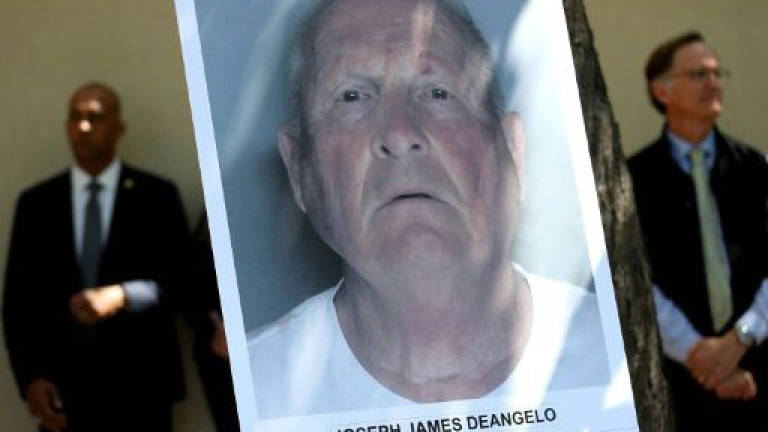'Golden State Killer,' an ex-cop, US Navy vet, warehouse worker

WASHINGTON: It was one of the most notorious unsolved crime sprees in US history — a decade-long series of sadistic rapes and murders that terrorized tranquil California neighborhoods.
They began in the summer of 1976 and ended abruptly in 1986 with the rape and murder of an 18-year-old girl.
Along the way, the meticulous masked assailant was given a number of nicknames: the East Area Rapist, the Original Nightstalker, the Golden State Killer ...
After a 40-year search, California authorities on Wednesday announced that they had finally caught their man — a 72-year-old named Joseph James DeAngelo. On Thursday, it was revealed that plugging DeAngelo's DNA profile into a commercial geneaology website led investigators to the killer.
"There were upwards of 50 rapes, 12 murders, crimes that spanned 10 years across at least 10 different counties," Sacramento County district attorney Anne Marie Schubert said in announcing the arrest.
DeAngelo was a former policeman, officials said, but they released little other information about him and how he was eventually tracked down.
Neighbours, co-workers and newspapers were filling in some of the details Thursday about a man who eluded law enforcement for more than four decades.
DeAngelo appears to have spent most of his life in and around Sacramento in central California apart from a stint in the US Navy during the Vietnam War.
He went to high school in a Sacramento suburb and obtained a bachelor's degree in criminal justice from Sacramento State after serving in the navy, according to the Sacramento Bee newspaper.
Sacramento County Sheriff Scott Jones said that from 1973 to 1976 DeAngelo served as a policeman in Exeter, south of Sacramento.
Exeter is near the town of Visalia, and DeAngelo is suspected of being the "Visalia Ransacker" who was burglarizing homes in the area.
'Don't scream'
From 1976 to 1979, DeAngelo worked for the police department in Auburn, California, until he was fired for shoplifting a hammer and a can of dog repellent.
The first rape committed by the man who would come to be known as the Golden State Killer took place in June 1976, when he broke into the home of a young girl while she was sleeping and her father was away.
"He had a ski mask on," the victim recounted years later in a tape recording released by the FBI two years ago in an effort to revive interest in the case.
"(He) jumped on the bed and had a knife," she said.
"I don't exactly remember what he said. Something to the effect of, you know, 'Don't scream,' don't, you know, whatever. And tied my hands behind my back."
According to the Sacramento Bee, DeAngelo retired last year after working since 1989 as a truck mechanic at a warehouse for a grocery store chain.
Jason Calhoon, a co-worker for the past 27 years, told the newspaper DeAngelo was a "regular Joe" although he never smiled.
For more than 20 years, DeAngelo has lived in Citrus Heights, about 32km northwest of Sacramento.
His tidy ranch house with a neatly manicured lawn in a suburban neighborhood has been cordoned off by police and FBI agents carting away boxes of evidence.
According to the Bee, DeAngelo was married in 1973 and Jones, the sheriff, said he has "adult children".
Jones said the authorities have interviewed some family members and they have been "cooperative." "It's quite a shock to them as you might expect", he said.
DeAngelo's next door neighbour, Cory Harvey, told the Sacramento Bee that the man she knew as "Joe" was divorced and lived with a daughter and granddaughter.
She said he was a good neighbor "except for that quirkiness of getting mad" and swearing out loud, after which he would apologize.
DNA was key
California authorities credited DNA technology with helping identify him.
The Sacramento Bee reported Thursday that investigators compared DNA from one of the crime scenes to profiles available on genealogical websites to which people curious about their family history submit samples.
By exploring family trees, investigators were led to DiAngelo via his distant relatives.
Sheriff Jones said DNA from the crime scenes was ultimately matched to a "discarded item" from DeAngelo recovered by law enforcement.
"Over the last few days as information started to point towards this individual we started some surveillance," Jones said. "We were able to get some discarded DNA and we were able to confirm what we thought we already knew, that we had our man".
"The answer was, and always was going to be, in the DNA," Sacramento County District Attorney Anne Marie Schubert added.
"We knew we could, and should, solve it using the most innovative DNA technology available at this time."
"This was a true convergence of emerging technology and dogged determination by detectives," Jones said.
"In this case justice was delayed," he said. "It wasn't swift but I can assure you it will be sure". — AFP